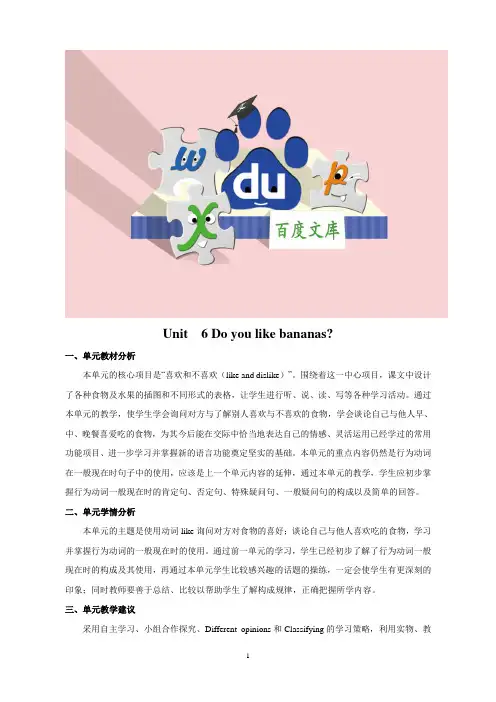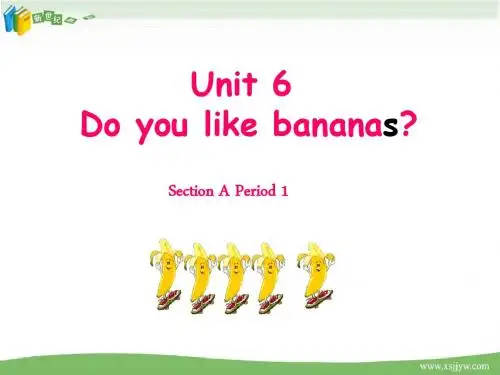unit 6 do you like bananasperiod1
- 格式:ppt
- 大小:5.81 MB
- 文档页数:29


Unit 6 Doyou like bananasﻫ【重点词语】1ﻫ. Frenchfries薯条 2. ice cream冰激凌 3. running star 跑步明星ﻫ4. lots of 许多,大量5. healthyfood 健康食品6.unhealthy food不健康食品7.make a list列表,制表8.eat/havebreakfast 吃早餐9. for breakfast对于早餐来说ﻫ【重难点分析】1ﻫ. 可数名词和不可数名词ﻫ(1)可数名词:ﻫ①定义:是可以计数的名词。
ﻫ②可数名词前可以用a,an限定。
③可数名词前可以用one,two,three…限定。
④可数名词有复数形式。
(2)不可数名词:①定义:指不能计数的名词。
ﻫ②不可数名词前不可以用a,an限定。
③不可数名词前不可以用one,two,three…限定。
ﻫ④不可数名词没有复数形式。
2ﻫ.名词变复数的变换规则(1)一般在名词词尾加-s.如:banana-bananas(2)以-o,-s,-sh,-ch及-x结尾的名词,在词尾加-es构成复数形式。
如:tomato -tomatoes(3)有些以-o结尾的名词仍加-s.如:photo-photos(4)以辅音字母加-y结尾的名词,把y去掉,加-ies.如:family-families(5)以-f或-fe结尾的名词,把f,fe去掉再加-ves.如:life-livesﻫ(6)有些名词以改变拼写来构成复数形式,即是不规则变化。
如:man-menﻫ(7)有些名词单、复数相同。
如:sheep-sheep英语中有些名词,即可用作可数名词,也可用作不可数名词,但它们汉语的意思有差别。
例如:fish表示“鱼的条数和种类”时,可数;表示“鱼肉或熟鱼”时,不可数。
chicken表示“鸡,小鸡”时,可数;表示“鸡肉”时,不可数。
orange表示“橘子”时,可数;表示“橘汁”时,不可数。

Unit6DoyoulikebananasPeriod1(SectionA1a-1c)Teachingaims1.Learnwordsandbeabletosay,readandwritethem:orange(s),banana(s),strawberry,strawberries,pear(s),appl e(s),tomato(es),carrot(s),vegetable(s),hamburger(s),egg( s),ice-cream(s),salad(s),bread,chicken2.Beabletotalkaboutlikesanddislikesbyusing:I/We/Theylikeoranges.He/Shelikesoranges.I/We/They don’tlike bananas.He/Shedoesn’tlikehamburgers.Doyoulikesalad Yes,Ido./No,Idon’t.Doeshe/sheliketomatoes Yes,he/shedoes./No,he/shedoesn’t.3.Understandthedifferencebetweencountablenounsanduncoun tablenouns.Teachingkeyanddifficultpoints:1.Learnthesewordsandbeabletosay,readandwritethem:2.Beabletotalkaboutlikesanddislikesbyusing:I/We/Theylikeoranges.He/Shelikesoranges.I/We/They don’tlike bananas.He/Shedoesn’tlikeh amburgers.Doyoulikesalad Yes,Ido./No,Idon’t.Doeshe/sheliketomatoes Yes,he/shedoes./No,he/shedoesn’t. Moralobjects(1)Tocallstudents’attentiontoothers’int erestsandenablethemtocaremoreaboutclassmates.(2)ToimproveSts’communicatingskillsandenablethemtokeepinEnglish(showapictureofsomemorewordsbyshowingpictures.GettheSstomakeaneffortt We/Theylike…We/Theydon’tlike…enandnumbertheconversations.(SectionA2a-2d) Teachingaims:1.Words&expressionsBirthday,dinner,week,thinkabout,food,sure,how /what about…Burger,vegetable,fruit,apple,then2.TargetlanguageIlikestrawberries,they’redelicious.Let’shav ethem.--Yes,Ilikethem,too./No,Idon’tlikethem.Ilikesalad,it’sdelicious.Doyoulikeit--Yes,Ido./No,Idon’tbutIlike icecream.Let’shave…Let’sthinkaboutthefood.AbilitygoalsEnablestudentstotalkaboutlikesanddislikes.LearningabilitygoalsHelpstudentslearnhowtotalkaboutlikesanddislik es.2.Listeningandspeakingskills.Moralobject:Learntokeephealthy.Teachingimportant/difficultpointsHowtotalkaboutlikesanddislikeswiththetargetla nguage.Teachingaims:Targetlanguage:DoyoulikesaladYes,Ido./No,Idon’t.DotheylikepearsYes,theydo./No,theydon’t.DoessheliketomatoesYes,shedoes./No,s hedoesn’t.Ilikeoranges,butIdon’tlike bananas.Welikerice.Wedon’tlikehamburgers.Helikesice-creambuthedoesn’tlike vegetables. Learningabilitygoals1.Helpthestudentslearnhowtotalkabouttheirlikesanddislikes.2.Helpthestudentsunderstandcountablenounanduncountablenoun. LearningdifficultandimportantpointsHowtotalkabouttheirfavoritefoods.Teachingaims:1.Words egg,carrot,rice,chicken,so.2.TargetlanguageDoesTomlikecarrotsYes,hedoesIlikecarrots!Abilitygoals1.Enablestudentstotalkaboutlikesanddislikesanddifferencebetweenfruitsandvegetables2.Listeningandspeakingskills.Moralobject:Learntokeephealthy.Teachingimportant/difficultpointsSstodiscussthelistsinpairsandw likes…and…Sallydoesn’tlike…(2a-2c)Teachingaims:1.Words:stareatwellhealthyreallyquestionwantbefat2.TargetlanguageWhatdoyoulikeforbreakfastDoyoulikehamburgersfordinnerAbilitygoals:1.EnablestudentstoreadthemagazinearticleaboutCindy’s favoritefoodsforthreemealsandwritefiv esentencesaboutCindy’seatinghabitsandretellC indy’seatinghabits2.Trainstudents’readingandwritingskills Moralgoals:Enablestudentscanformgoodeatinghabitsandkeeph ealthy.Teachingimportant/difficultpoints:1.Keywordsandsentences:2.Trainstudents’readingandwritingskills3.TalkaboutCindy’seatinghabitsusing“Whatdoyoulikefor….Ithink…WhatfruitdoyoulikeWhataboTeachingaims:1.Wordsapple,icecream,banana,broccoli,like,oranges,c arrot,breakfast,chicken,tomato,lunch,hamburge r,fruit,dinner,Frenchfries,vegetable,pear2.Targetlanguage:Ilike…Idon’tlike…Forbreakfast/lunch/dinn er,Ilike…Abilitygoals1.Enablestudentstolearntowritetheirfavoritefoodformeals2.LearningabilitygoalsHelpstudentslearnhowtowriteapassageabouttheyl ikeanddislikefordinner.Teachingimportant/difficultpoints:。

Unit6《Doyoulikebananas》教学设计完美版Unit 6: Do you like bananas?教学设计完美版Introduction:In this unit, students will explore the topic of fruits, specifically focusing on bananas. They will learn new vocabulary related to bananas, practice speaking and listening skills, and participate in various engaging activities to reinforce their understanding.Lesson 1: Banana FactsObjective:- To introduce the topic of bananas- To learn new vocabulary related to bananasMaterials:- Pictures of different types of bananas- Flashcards with banana-related vocabularyProcedure:1. Show pictures of different types of bananas and ask students if they can identify them.2. Introduce the topic of bananas and discuss their popularity around the world.3. Present the flashcards with banana-related vocabulary and have students repeat the words after you.4. Use the flashcards in a matching game, where students match the vocabulary word to the corresponding picture.Lesson 2: Banana TastingObjective:- To provide students with a hands-on experience of tasting different bananas- To practice describing the taste and texture of bananasMaterials:- Different varieties of bananas (ripe and unripe)- Paper plates for each studentProcedure:1. Distribute small pieces of different types of bananas to each student.2. Instruct students to taste each banana and describe the taste and texture using adjectives.3. Encourage students to share their thoughts and opinions about each variety of banana.4. Have a class discussion about the different flavors and textures of the bananas.Lesson 3: Banana Smoothie RecipeObjective:- To practice following instructions- To reinforce banana-related vocabularyMaterials:- Recipe cards for banana smoothies- Blender- Ingredients (bananas, milk, honey, ice, etc.)Procedure:1. Introduce the recipe for banana smoothies and go over the ingredients and instructions.2. Divide the class into small groups and assign each group a recipe card.3. Instruct students to follow the recipe instructions and make their own banana smoothies.4. Have each group present their smoothie and share their experience. Encourage students to use the newly learned vocabulary to describe the taste and texture of their smoothies.Lesson 4: Banana InterviewsObjective:- To practice asking and answering questions- To develop speaking and listening skillsMaterials:- Question cards related to bananasProcedure:1. Divide the class into pairs and provide each pair with question cards.2. Instruct students to take turns asking and answering questions related to bananas.3. Encourage students to ask follow-up questions and engage in a conversation.4. Monitor students' conversations and provide feedback on their language use and pronunciation.Lesson 5: Banana ArtObjective:- To promote creativity and artistic expression- To review banana-related vocabularyMaterials:- Paper- Colored pencils or markersProcedure:1. Provide each student with a piece of paper and colored pencils or markers.2. Instruct students to draw a picture of their favorite banana-related scene or activity.3. Encourage students to use the new vocabulary words in their drawings.4. Display the artwork around the classroom and have each student explain their drawing to the class.Conclusion:By the end of this unit, students will have developed a strong understanding of bananas and related vocabulary. They will have practiced speaking and listening skills through various activities and will have had the opportunity to explore their creativity through art. This comprehensive and engaging teaching design provides students with a well-rounded learning experience.。

Unit 6 Do you like bananas?一、单元教材分析本单元的核心项目是“喜欢和不喜欢(like and dislike)”。
围绕着这一中心项目,课文中设计了各种食物及水果的插图和不同形式的表格,让学生进行听、说、读、写等各种学习活动。
通过本单元的教学,使学生学会询问对方与了解别人喜欢与不喜欢的食物,学会谈论自己与他人早、中、晚餐喜爱吃的食物,为其今后能在交际中恰当地表达自己的情感、灵活运用已经学过的常用功能项目、进一步学习并掌握新的语言功能奠定坚实的基础。
本单元的重点内容仍然是行为动词在一般现在时句子中的使用,应该是上一个单元内容的延伸,通过本单元的教学,学生应初步掌握行为动词一般现在时的肯定句、否定句、特殊疑问句、一般疑问句的构成以及简单的回答。
二、单元学情分析本单元的主题是使用动词like询问对方对食物的喜好;谈论自己与他人喜欢吃的食物,学习并掌握行为动词的一般现在时的使用。
通过前一单元的学习,学生已经初步了解了行为动词一般现在时的构成及其使用,再通过本单元学生比较感兴趣的话题的操练,一定会使学生有更深刻的印象;同时教师要善于总结、比较以帮助学生了解构成规律,正确把握所学内容。
三、单元教学建议采用自主学习、小组合作探究、Different opinions和Classifying的学习策略,利用实物、教学图片等来展开课堂pairwork问答式或groupwork讨论式的口语交际活动,使用like询问对方对食物的喜好和谈论自己、他人喜欢吃的食物。
本单元的教学法建议:语音教学——让学生进行模仿操练;词汇教学——采取演示讲解的方式进行教学,让学生进行情景操练、反复使用;口语教学——采取pairwork问答式和groupwork讨论式的口语交际活动互相操练练习;阅读教学——让学生学会抓住主要词汇和句型;听力教学——采取图文配对和对话选择的方式;写作教学——以填空、造句为主;语法教学——比较不同、总结规律、模仿操练。


Unit6 Do you like bananas?SectionA period oneTeaching aims:1.knowledge objects(1)Function:Let the Ss know how to talk about their likes and dislikes. Learn somenew words ab o ut food。
(2)Keyvocabulary:hamburgers,tomatoes,oranges,ice-cream,salad,bananas strawberries,pears,milk,bread(3)Target language:①-I like bananas。
Do you like bananas?—Yes,I do./No,I don’t。
②-I don’t like salad。
Do you like salad?—Yes,I do./No,I don’t.③—Does he/she like hamburgers?—Yes,he/she does.He/She likes…No,he/she doesn’t。
He/She doesn’t like(4)Structure:The countable nouns and uncountable nouns.2。
Ability objects:To learn to talk about likes and dislikes.3.Moral objects:Learn to care about others。
Teaching key points:new words;sentence patternsTeaching difficult points:To talk about the countable nouns and uncountable nouns. Teachingmethods:Pairwork;Groupwork;Free talk;Listening Teaching aids:ppt; some real objectsTeaching procedures:Step1:Lead in(1)Show a ping—pong ball。

Unit 6 Do you like bananas?单词回顾香蕉汉堡包西红柿冰激凌沙拉草莓梨子牛奶面包生日正餐周,星期思考食物当然,肯定蔬菜水果正确的苹果那么蛋,鸡蛋胡萝卜大米,米饭鸡肉早餐午餐星星吃习惯健康的真正地问题问题想要肥胖的一.短语归纳:1。
John's birthday dinner 约翰的生日晚餐 2。
next week 下周3.think about 思考、考虑 4。
how about 怎么样5。
some fruit 一些水果 6。
his birthday 他的生日7。
sport star 体育明星 8.eating habits 饮食习惯9.for breakfast 作为早餐 10。
for dinner 作为晚餐11。
one last question 最后一个问题 12。
healthy food 健康的食品二.重点句型:1。
have sth 吃……2。
—Do you like…? 你喜欢…吗?—Yes, I do / No, I don’t. 是的,我喜欢/不,我不喜欢。
3。
—Does she / he like…?她/他喜欢…吗?—Yes, she / he does.—No, she/ he does’t4.I like/ don’t like…我喜欢/ 我不喜欢…5。
like … for breakfast / lunch / dinner 早餐/午餐/晚餐喜欢…6.want to do sth 想要做某事三.典句必背1。
I like hamburgers。
我喜欢汉堡包。
2. He likes ice—cream。
他喜欢冰激凌.3. —Do you like salad?你喜欢沙拉吗?— Yes, I do. / No, I don’t. 是的,我喜欢./ 不,我不喜欢。
4。
I don't like bananas。
我不喜欢香蕉。
5.I don't want to be fat。

Unit 6 Do you like bananasUnit 6 Do you like bananas 教学设计⑥Section 2一、Teaching Goal:In this unit students learn to talk about what people are doing. Teach students how to cooperate and be good at watching something and love our lives.二、Teaching difficulties1. The vocabulary and the sentence structures.2. Learn the grammar: Present progressive tense.3. Oral practice using the target language.三、Teaching MethodsListening and practicing methods, pair work, Task-Based Learning method.四、Teaching AidsA tape recorder, some pictures and cards.五、Teaching Time: 5 periodsPeriod 1 (Section A:1a—2b)Teaching ProceduresStep 1.Revision1. Greetings.2. Revise the words and expressions in Unit 4.Step 2.Presatation: Lead in1. Do “Ask and answer〞 practice with the Ss.2. The teacher asks the students to give more verbs phrases and write them down on the blackboard.(show many pictures to help the Ss.)Teach the new words and expressions.3. Teach the Present Progressive.1〕Introduction: Talk about the title of this unit. Show some pictures to introduce the Present Progressive tense.T: What’s she/he doingSs:She/He is v-ing (Help the Ss to answer the questions and show the sentences)2) Let the Ss to say what the Present Progressive is.(现在进行时表示现在正在进行或发生的动作, 它的表现形式为:Be Verbs + V-ing ….)3). Tell the differenceWrite down the V-ing forms by another lines of go, watch, do, play and eat . Ask the Ss to have a look and find the difference between them. For example: go and going, watch and watching, do and doing, etc. Then ask the Ss to read them again and do more exercises.Step3.Activity 1a:Match1. Help the Ss talk about the pictures. The Ss read these V-ing wordsafter the teacher. Match the words and the activities. Check the answers.2. Help the Ss do “Ask and answer〞 practice in pairs.3. Ask some Ss to do actions and let the class guess what he/she is doing. Step4.Activity 1b & 1c: Listening and pair work.1. Play the recording for the Ss to listen. Play again. Ss listen and write the number of the activity each person is doing. Check the answers.2. Pairwork: Ask the Ss to do “Ask and answer〞 practice about the picture in pairs. Some pairs present their dialogues to the class.Step 5.Activity 2a & 2b: Listening and Practice1.Activity 2a:Talk about the picture in 2b.Ask the Ss to read the questions in 2a. Then listen to the tape and and write the answers. Check the answers.2.Activity 2b:Play the recording again. Help the Ss put these questions and answers in order to make a conversation. Go through the answers with the Ss.Step 6 Pairwork: Activity 2c1.Talk about the pictures in 2c. Ask Ss to read the sample conversation. Let Ss lookat the first group of pictures, and ask them to guess what the people are doing.2. Then imitate the sample conversation, work in pairs. Some pairs present their dialogues to the class.3. A guessing game: Guess the activities ac cording to the Ss’ actions.Step 7 Grammar focusGo through the sentences with the Ss. Deal with some language points.Step 8 Homework: 1.Copy the new words and recite.2.Make up their own dialogues.。


Unit 6 Do you like bananas? Part 1 Words and Expressionsbanana /bə'nɑːnə/ n. 香蕉hamburger /'hæmbɜː(r)gə(r)/ n.汉堡包tomato /tə'mɑːtəʊ/ /tə'meɪtəʊ/ n. 西红柿ice-cream /,aɪs'kri:m/ n.冰激凌salad /'sæləd/ n. 沙拉strawberry /'strɔːbəri/ n.草莓pear/peə(r)/ n. 梨milk /mɪlk/ n.牛奶bread /bred/ n. 面包birthday /'bɜː(r)θdeɪ/ n.生日dinner /'dɪnə(r)/ n.(中午或晚上吃的)正餐week /wiːk/ n.周;星期think about 思考;思索food /fuːd/ n.食物sure /ʃʊə(r)/ adv.当然;肯定;一定How about…? (提出建议)……怎么样?burger /'bɜː(r)gə(r)/ n. (= hamburger) 汉堡包vegetable /'vedʒtəbl/ n. 蔬菜fruit /fruːt/ n.水果right /raɪt/ adj.正确的;适当的apple /'æpl/ n.苹果then /ðen/ adv.那么egg /eg/ n.蛋;鸡蛋carrot /'kærət/ n.胡萝卜rice /raɪs/ n. 大米;米饭chicken /'tʃɪkɪn/ n. 鸡肉so /səʊ/ conj.(引出评论或问题)那么breakfast /'brekfəst/ n.早餐;早饭lunch /lʌntʃ/ n. 午餐star /stɑː(r)/ n.明星;星星eat /iːt/ v.吃well /wel/ adv. 好;令人满意地habit /'hæbɪt/ n.习惯healthy /'helθi/ adj. 健康的really /'riːəli/ adv. 真正地question /'kwestʃən/ n.问题want /wɒnt/ v. 需要;想要be /biː/ v.变成fat /fæt/ adj. 肥的;肥胖的Part 2:Texts课文(一)Jack: Hey, John’s birthday dinner is next week. Let’s think about the food. Tom: Sure. How about burgers, vegetable salad, and some fruit?Bill: Sounds good. John likes hamburgers.Jack: Oh, I don’t like salad.Bill:But John likes salad, and it’s his birthday.Jack:Yes, you’re right. What about the fruit?Tom: I think John likes strawberries and apples.Jack:OK. Let’s have strawberries and apples then.Structure——谈论好恶1.Do you like salad? Yes, I do./No, I don’t.2.Do they like pears? Yes, they do./ No, they don’t.3.Does she like tomatoes? Yes, she does./ No, she doesn’t.4.I like oranges. I don’t like bananas.5.We like rice. We don’t like hamburgers.6.He likes ice-cream. He doesn’t like vegetables.重点句型:Underline the correct words in the brackets.在括号内正确的单词下画线。